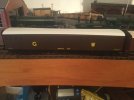It might be ambitious to describe this as “weathering”, but I’ve taken the RTR shine off it:

There are a few photos in Russell’s coach bible but there’s only one of an inside framed Siphon without the later ventilators. In any case, they seem to be universally “matt dirty” - certainly more so than I want to do to a new model anyway.
Model comments
I think it’s a duck, it walks & talks like one and I can’t see anything glaring. Very pleased with my purchase, all the exterior detail looks present & correct to me, brake shoes are reasonably close to the wheels, slightly outboard, probably enough room to go S7 if that’s your thing.
I will dig out my other brown vehicles and make a train just to have a look.

Wheels are blackened, but look distinctly metallic-glossy. They run fine through my home built pointwork, I assume they’re compatible with Peco. Bogies secured with central screw & spring - it doesn’t appear to wobble. In common with other Minerva (and Dapol) RTR the coupling springs are the weak and wibbly side of wimpish and need sorting out.
Insides of corridor connectors are brilliant white - I guess this could be seen as “glaring”

Bags of bits supplied with model - mild concern on delivery that package rattled but it was the loose bits in their plastic bags. There are lower body vents, battery boxes and roof ventilators to fit if required. I’ll fit the battery boxes, not the other bits.
Model very well packed. Seems like a sensible weight, rolls freely.
What I’ve done so far
Painted ends of brake handles white, painted insides of corridor connectors very dark grey, painted axleboxes tops & dampers blue
Weathering mix of mahogany, black & rust applied to inside and outside faces of wheels including rims but not treads
Thin version of similar mix sprayed quite heavily over bogies, less so over solebars and ends, and gently over rest of body
Very thin wash of black sprayed very lightly over roof
All the paints were Vallejo
What I should have done / will do
Fit the battery boxes before spraying chassis - prat - job for later when it’s all dried.
Possible application of some dark rust wash to bogies particularly brakes and wheels
Open hand holes in doors - they’re a bit low-relief
Improve coupling springs
Bit of oily steel metalcote on the buffer heads, maybe edges of steps, etc
One happy shopper


















